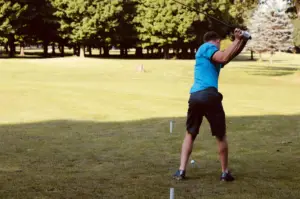Golf is a game of precision and strategy, and being able to shape your shots can give you a significant advantage on the course. One shot that many golfers aspire to master is the fade. A fade, also known as a cut shot, is a controlled ball flight that curves gently from left to right for right-handed players (and right to left for left-handed players). Unlike a slice, which is an uncontrollable and erratic shot, a well-executed fade can help you save strokes and keep the ball in play. In this comprehensive guide, we will explore the techniques and strategies you need to master in order to consistently hit a fade in golf.
Understanding the Fade Shot
Before we delve into the mechanics of hitting a fade, it’s important to have a clear understanding of what exactly a fade shot is. A fade is a controlled ball flight that starts left of the target (for right-handed golfers) and gently curves back to the right, ultimately finishing near the target line. It is a shot that requires precision and finesse, and when executed correctly, it can help you navigate tight fairways and avoid hazards with ease.
The Importance of Grip
One of the fundamental elements that contribute to hitting a successful fade shot is your grip. The way you hold the club has a direct impact on the clubface position at impact and ultimately determines the direction and shape of your shots. When it comes to gripping the club for a fade, there are a few key considerations.
Firstly, you want to have a slightly weaker grip than your normal grip. This means rotating your top hand (left hand for right-handed golfers) counterclockwise, so that you see two knuckles instead of three at address. This grip adjustment helps prevent your wrists from rolling over, which tends to produce a draw or hook. Additionally, you can experiment with holding the club more in the palm of your top hand rather than in the fingers, as this can promote a more controlled release through impact.
Your bottom hand should also be adjusted to complement the top hand. It should be rotated slightly in the same direction as the top hand, creating a unified grip that promotes a fade shot shape. Finding the right balance and comfort with your grip is crucial, as it sets the foundation for executing a successful fade shot.
Perfecting Your Stance
In addition to the grip, your stance plays a vital role in hitting a consistent fade shot. The positioning of your feet and body alignment can greatly influence the path and direction of your ball flight. When setting up for a fade shot, there are a few key elements to consider.
Firstly, you want to aim slightly left of your target (for right-handed golfers) to allow for the left-to-right shape of the fade. This means aligning your body and clubface slightly left of your intended target line. It’s important to note that your aim should be adjusted based on the degree of fade you want to achieve. For shorter shots, the aim may only need to be a few yards left, while for longer shots, a larger aim adjustment may be necessary.
Additionally, your clubface should be square to your target line or slightly open at address. This means that the toe of the club should be pointing slightly away from the ball. This open clubface position helps promote the left-to-right curvature of the fade shot. It’s essential to find the right balance with your clubface position, as too much opening can result in a push or slice.
Lastly, your body alignment should reflect your target line and aim. Your feet, hips, and shoulders should be aligned parallel to your intended target line, but slightly left of it to accommodate the fade shot shape. This alignment ensures that your swing path and clubface angle work together to produce the desired fade ball flight.
Executing the Swing
With a solid grip and proper setup, it’s time to focus on the swing itself. The swing path and clubface angle are critical factors in achieving a consistent fade shot. There are two main approaches to executing a fade: opening the clubface or swinging slightly across the target line.
Opening the Clubface
One method to hit a fade is to open the clubface at address. This means rotating the toe of the club slightly away from the ball. By doing so, you create a clubface angle that promotes a left-to-right ball flight. It’s important to note that the degree of clubface opening should be adjusted based on the desired amount of fade. Too much opening can lead to a push or slice, while too little opening may result in a straight shot.
When using the open clubface method, it’s crucial to maintain a consistent swing path. Your swing should follow an outside-to-in path, meaning the club is moving from the outside (right) to the inside (left) through impact. This swing path, combined with the open clubface, imparts the desired left-to-right spin on the ball, resulting in a controlled fade shot.
Swinging Across the Target Line
Another approach to hitting a fade is to swing slightly across the target line. Instead of relying solely on the clubface angle, this method focuses on the swing path. To execute a fade using this method, you want to have a slightly outside-to-in swing path, with the clubhead attacking the ball from the right side (for right-handed golfers). This swing path, combined with a square or slightly open clubface, imparts the necessary left-to-right spin on the ball.
It’s important to note that when employing this method, it’s crucial to maintain a smooth and controlled swing. Swinging too aggressively or with excessive force can result in a slice or pull. Focus on maintaining a steady tempo and rhythm throughout the swing, allowing your body and arms to work together harmoniously.
Practice and Fine-Tuning
Mastering the art of hitting a fade requires practice, patience, and a willingness to experiment with different techniques. As with any aspect of golf, consistent practice is key to developing a reliable fade shot. Here are some tips to help you fine-tune your fade:
- Start with shorter shots: Begin by practicing the fade with shorter clubs, such as wedges or short irons. This allows you to focus on the mechanics and feel of the shot without the added complexity of longer clubs.
- Gradually increase club length: Once you feel comfortable with the fade using shorter clubs, gradually progress to longer clubs. Practice hitting fades with mid-irons, long irons, and eventually fairway woods and drivers. Each club requires slight adjustments in grip, setup, and swing path, so take the time to familiarize yourself with the nuances of each club.
- Experiment with grip adjustments: While we discussed a standard grip adjustment for hitting a fade, it’s important to note that individual preferences may vary. Don’t be afraid to experiment with different grip variations to find what feels most comfortable and effective for you.
- Film and analyze your swing: Use a smartphone or camera to record your swing from various angles. This allows you to review your technique and identify any areas that need improvement. Pay attention to your grip, setup, swing path, and clubface position at impact. Compare your swing to professional golfers known for their fade shots, such as Jack Nicklaus or Lee Trevino, to gain insights and inspiration.
- Seek professional guidance: If you’re struggling to consistently hit a fade or fine-tune your shot shape, consider seeking guidance from a golf instructor. A qualified instructor can provide personalized feedback and help you make necessary adjustments to improve your fade shot.
Remember, mastering a fade shot takes time and dedication. Be patient with yourself and embrace the learning process. With practice and perseverance, you’ll develop the skills needed to confidently hit a controlled fade on the golf course.
Benefits of Hitting a Fade
Now that we’ve covered the techniques and strategies for hitting a fade, let’s explore the benefits of incorporating this shot into your game. Hitting a fade consistently can offer several advantages:
- Control and accuracy: The fade shot allows you to have more control over your ball flight, leading to increased accuracy. By shaping your shots from left to right (for right-handed golfers), you can navigate challenging fairways, avoid hazards, and position the ball closer to your target.
- Distance control: With a fade, you can achieve consistent distance control, as the shot tends to land softly and stop quickly. This is particularly useful when approaching greens or hitting shots from tight lies.
- Course management: A well-executed fade shot can help you strategically navigate a golf course. By understanding how to shape your shots, you can take advantage of the layout and design of each hole, setting yourself up for more favorable approach shots and scoring opportunities.
- Confidence and versatility: Being able to shape your shots gives you a sense of confidence and versatility on the course. You’ll have more options at your disposal, allowing you to adapt to different course conditions, wind directions, and pin positions.
Conclusion
Hitting a controlled fade in golf is a skill that can elevate your game to new heights. By mastering the techniques and strategies outlined in this guide, you’ll be able to shape your shots with precision and confidence. Remember to focus on your grip, setup, swing path, and clubface position, as these elements are crucial in executing a consistent fade shot. With practice and perseverance, you’ll soon find yourself confidently shaping the ball from left to right, navigating the course with ease, and lowering your scores. Embrace the challenge, enjoy the process, and watch your game soar to new levels.




